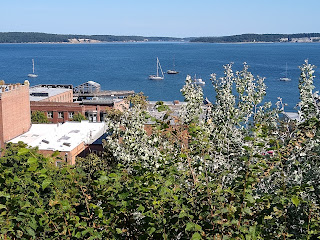My favorite place to visit here on the Olympic Peninsula is Fort Flagler on Marrowstone Island. The former coast artillery fort is now a state park offering the best views of Puget Sound you can hope to find, including powerful currents and marine wildlife to watch, historical military structures to explore, and let’s toss in a lighthouse (well, sort of) for good measure. All these
features make it an endlessly entertaining place to visit for a day, a weekend, or longer.
The historical photo for today’s blog post really blew my
mind when I first saw it. It's a shot of Marrowstone Point from 1898, when Fort Flagler was under construction. I hope you enjoy my now photo, but you really
should go to Jefferson County Historical Society’s site and look at the original historical photo. There are so many fascinating details to spot. Those are enormous cannon barrels being brought ashore from a barge on the beach. And in the distance on the left is the Marrowstone Light Station keeper's residence.
Construction of Fort Flagler began in 1897 but the U.S. government was active here a decade earlier in the interest of maritime safety. A light to guide mariners has shone at Marrowstone Point in one
form or another since 1888, but not from the traditional lighthouse tower that most of us would
think of. Starting with a lens lantern mounted on a pole, the light eventually was erected atop a 20 ft. concrete building where it has been located since 1918.
The light keeper's residence in both our now and then photos has acted as
sentinel, standing at the shoreline since 1896. Just offshore, Puget Sound's unwieldy winds and dense fog can make navigating the strong currents rushing through narrow Admiralty Inlet a harrowing experience for vessels of any size. One calamitous event happened here in 1892 when the freighter S.S. Willamette rammed the S.S. Premier at full speed, killing five and injuring 18. Although neither ship sank, the damage to the Premier was significant to say the least. Take a look for yourself. 😮
The light still shines, now automated, but since the mid-1970s the site and structures have primarily served federal scientific research as the U.S. Geological Survey’s Marrowstone Marine Field Station. Their current work is focused on fish and overall marine ecosystem health. The light keeper's residence provides lodging for visiting scientists.
 |
Marrowstone Point 1895 map
(National Archives)
|
I have not been able to track down information on the barn
or other buildings we see in the historical photo. But on a
map of the fort from 1913,
the buildings are labeled as “old stables” and “old laundry.” Structures also
appear on
a map from 1895, but have no information. If anyone knows more, please
share.
 |
Fort Flagler 1913 map
(National Archives) |
In addition to these maps, the National Archives website has several
interesting photos including the document below showing the earlier structure on which the light was placed, and the front of the keeper's quarters with its fog bell. Both structures still stand and can be seen today (minus the bell).
 |
1915 images of Marrowstone Point Light Station
(National Archives)
|









